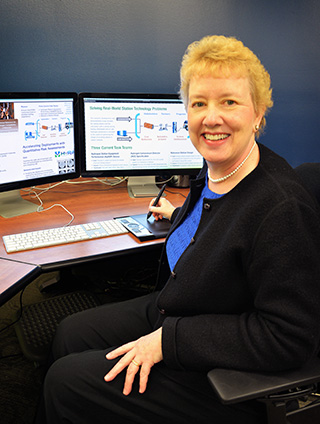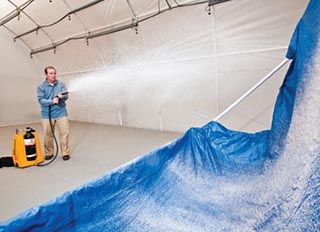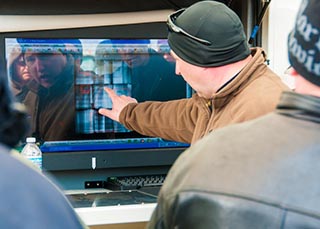Sandia takes home three national tech transfer awards

Sandia won the national Federal Laboratory Consortium’s (FLC) 2016 Award for Excellence in Technology Transfer for a decontamination product that neutralizes chemical and biological agents and for software that helps emergency responders more effectively disable improvised explosive devices (IEDs). And business development specialist Bianca Thayer was named Outstanding Technology Transfer Professional of 2016.
The awards recognize employees of FLC member laboratories and non-laboratory staff who have accomplished outstanding work in the process of transferring federally developed technology. A panel of experts from industry, state and local government, academia, and the federal laboratory system judge the nominations.
Bianca’s award, one of the FLC’s highest honors, recognizes one person who demonstrated outstanding achievement transferring a technology significantly over and above what was called for in the normal course of work.
“Sandia is truly honored to be recognized by our peers for our work in technology transfer,” says Jackie Kerby Moore, manager of Technology and Economic Development Dept. 1933 and Sandia’s representative to the FLC. “Congratulations to Bianca and the Sandia teams who are being acknowledged for their accomplishments.”
A passion for tech transfer
Bianca started her Sandia career five years ago as a licensing executive in Albuquerque after working 30 years in industry. She has negotiated new industry and academic partnerships and transferred a wide range of Labs technologies through licensing and cooperative research and development and Work for Others agreements. She also developed the TEDS courses for intellectual property and licensing and has personally trained many technical staff on the value of IP.
Among Bianca’s successes was negotiating the patent license in 2012 with UOP Honeywell for crystalline silico-titanates used to remove radioactive cesium from contaminated seawater following the Fukushima nuclear power plant disaster in Japan. She also negotiated numerous new licenses for Sandia’s decontamination technology resulting in more widespread use of the product.
Her manager, Carrie Burchard, says Bianca, who transferred to Sandia/California in 2013, “is constantly thinking of new ways to help her licensees be successful in commercializing technologies from Sandia. She’s got a true passion for technology transfer.”

CLEANING UP — Researcher Mark Tucker demonstrates Sandia’s decontamination formula. The product, used 15 years ago to disinfect facilities following the deadly 2001 anthrax attacks, is now being used by a variety of companies to clean meth labs and other toxic sites. (Photo by Randy Montoya)
Decon technology licensed to companies
Decontamination Technology for Chemical and Biological Agents, which also won a Far West/Mid-Continent regional FLC award last year, uses a mix of mild, nontoxic, and noncorrosive chemicals found in common household products such as hair conditioner and toothpaste. It contains both surfactants that lift agents off a surface and mild oxidizers that break down the agent’s molecules into nontoxic pieces that can be washed down a household drain like detergent or dish soap.
The product works quickly and kills 99.99999 percent of bacteria, viruses, and fungi. Originally used by the military and first responders, Sandia has licensed the formula to companies that have developed it to battle toxic mold and decontaminate meth labs, disinfect healthcare facilities and schools, remove pesticides from farm equipment and agricultural packing plants, and fight the spread of the Ebola virus in Africa. It also has been used as a preventive measure at presidential debates and a political convention.
Sandia has promoted the technology, worked with companies to license and commercialize it, and adapted it for new products and uses. Seven new licensees are manufacturing and distributing products based on the Sandia decontamination patents. Efforts continue to add more licensees and product applications.
The decontamination formula was developed with funding from DOE and NNSA’s Chemical and Biological National Security Program. And Sandia’s Laboratory Directed Research and Development (LDRD) program has supported a variety of projects involving decontamination systems.

TRICKY PURSUIT — Explosive ordnance disposal technicians use Sandia’s XTK software to help analyze and disable an improvised explosive device. XTK is estimated to be used by more than 20,000 people in most of the 467 recognized non-military bomb squads across the country. (Photo by Jeff Hoffman/Honeywell)
A standard in the bomb disposal field
X-Ray Toolkit (XTK) is a software program developed by Sandia for the federal government with funding from NNSA and the Technical Support Working Group. The image processing and analysis software helps emergency responders better perform in the high-stress, time-critical act of disabling IEDs.
It has become the field standard due in part to being easy to use and built specifically for explosive ordnance disposal (EOD) personnel. A unique multifaceted deployment model contributed to its rapid and widespread acceptance.
XTK replaced multiple-imaging software packages EOD teams used with X-ray scanners. Sandia developers spent hundreds of hours with teams learning how they work, and designed an application that is intuitive, versatile, compatible with most X-ray scanners, and better suited to the needs of bomb disposal technicians.
Sandia also designed the patented Grid-Aim system as an optional hardware accessory kit for XTK. Grid-Aim lets users precisely disrupt and disable the internal components of an IED while preserving the rest of the device for evidence and minimizing damage to surrounding property and infrastructure.
To get XTK to the people who need it, Sandia offered no-cost end user licenses and free test and evaluation licenses for scanner manufacturers. Creative technology transfer methods helped XTK spread through the emergency response community. It is estimated to be in the hands of more than 20,000 users in most of the 467 recognized non-military bomb squads across the US. It also has been adopted by the FBI’s Hazardous Devices School for all its courses.
Sandia saved the emergency response community millions of dollars in licensing fees and training costs by offering the software free of charge and developing efficient ways to supply the XTK application, hardware accessories, and training.
The FLC is a nationwide network of about 300 members that provides the forum to develop strategies and opportunities for linking laboratory mission technologies and expertise with the marketplace.
The FLC Awards Program annually recognizes federal laboratories and their industry partners for outstanding technology transfer efforts and has become one of the most prestigious honors in technology transfer. Since its establishment in 1984, the FLC has presented awards to more than 200 federal laboratories.
“Decon technology and the X-Ray Toolkit are great examples of how Sandia’s scientific research translates into products that benefit the public,” says Pete Atherton, senior manager of Industry Partnerships Dept. 1930. “We look forward to working with partners to make these and other innovations widely available, and Bianca is one of our team members who has demonstrated outstanding achievement transferring technologies.”